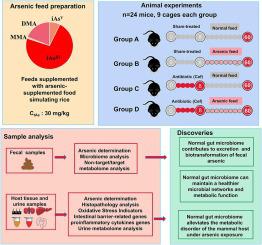Environment International ( IF 10.3 ) Pub Date : 2022-11-29 , DOI: 10.1016/j.envint.2022.107660 Linkang Chen 1 , Chengji Li 2 , Xiaoting Zhong 1 , Chengze Lai 1 , Bin Zhang 1 , Yu Luo 1 , Honghui Guo 1 , Keqing Liang 1 , Jingwen Fang 1 , Xuan Zhu 1 , Jingjing Zhang 3 , Lianxian Guo 1

|
Gut microbiome can participate in arsenic metabolism. However, its efficacy in the host under arsenic stress is still controversial. To clarify their roles in fecal arsenic excretion, tissue arsenic accumulation, host physiological states and metabolism, in this study, ninety-six C57BL/6 male mice were randomly divided to four groups, groups A and B were given sterile water, and groups C and D were given the third generation of broad-spectrum antibiotic (ceftriaxone) to erase the background gut microbiome. Subsequently, groups B and D were subchronicly exposed to arsenic containing feed prepared by adding arsenical mixture (rice arsenic composition) into control feed. In group D, the fecal total arsenic (CtAs) decreased by 25.5 %, iAsIII composition increased by 46.9 %, unclarified As (uAs) composition decreased by 92.4 %, and the liver CtAs increased by 26.7 %; the fecal CtAs was positively correlated with microbial richness and some metabolites (organic acids, amino acids, carbohydrates, SCFAs, hydrophilic bile acids and their derivatives); and fecal DMA was positively correlated with microbial richness and some metabolites (ferulic acid, benzenepropanoic acid and pentanoic acid); network analysis showed that the numbers of modules, nodes, links were decreased and vulnerability was increased; some SCFAs and hydrophilic bile acid decreased, and hydrophobic bile acids increased (Ps < 0.05). In the tissue samples of group D, Il-18 and Ifn-γ gene expression increased and intestinal barrier-related genes Muc2, Occludin and Zo-1 expression decreased (Ps < 0.05); serum glutathione and urine malondialdehyde significantly increased (Ps < 0.05); urine metabolome significantly changed and the variation was correlated with six SCFAs-producing bacteria, and some SCFAs including isobutyric acid, valeric acid and heptanoic acid decreased (Ps < 0.05). Therefore, the normal gut microbiome increases fecal arsenic excretion and biotransformation, which can maintain a healthier microbiome and metabolic functions, and alleviate the metabolic disorder for their mammal host under arsenic exposure.
中文翻译:

肠道微生物组促进砷代谢并减轻其哺乳动物宿主在砷暴露下的代谢紊乱
肠道微生物组可以参与砷代谢。然而,其在砷胁迫下对宿主的疗效仍有争议。为了阐明它们在粪便砷排泄、组织砷积累、宿主生理状态和代谢中的作用,本研究将 96 只 C57BL/6 雄性小鼠随机分为 4 组,A 组和 B 组给予无菌水,C 组和 D 被给予第三代广谱抗生素(头孢曲松)以清除背景肠道微生物组。随后,B 组和 D 组亚慢性暴露于通过将砷混合物(大米砷组合物)添加到对照饲料中制备的含砷饲料。D组粪便总砷(C tAs)下降25.5%,iAs III成分增加46.9%,未澄清的As(uAs)成分减少92.4%,肝脏C tAs增加26.7%;粪便C tAs与微生物丰富度和一些代谢物(有机酸、氨基酸、碳水化合物、SCFAs、亲水性胆汁酸及其衍生物)呈正相关;粪便DMA与微生物丰富度和某些代谢物(阿魏酸、苯丙酸和戊酸)呈正相关;网络分析表明模块数、节点数、链接数减少,脆弱性增加;部分SCFAs和亲水性胆汁酸减少,疏水性胆汁酸增加(Ps < 0.05)。在 D 组的组织样本中,IL-18和Ifn-γ基因表达增加,肠屏障相关基因Muc2、Occludin、Zo-1表达减少(Ps < 0.05);血清谷胱甘肽和尿丙二醛显着升高(Ps < 0.05);尿液代谢组发生显着变化,变异与 6 种 SCFAs 产生菌相关,异丁酸、戊酸和庚酸等部分 SCFAs 降低(Ps < 0.05)。因此,正常的肠道微生物组增加了粪便中砷的排泄和生物转化,可以维持更健康的微生物组和代谢功能,并减轻其哺乳动物宿主在砷暴露下的代谢紊乱。











































 京公网安备 11010802027423号
京公网安备 11010802027423号